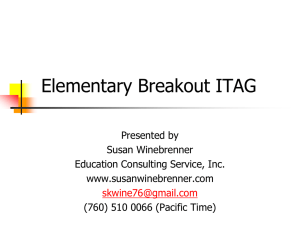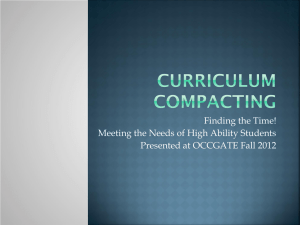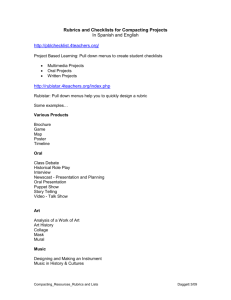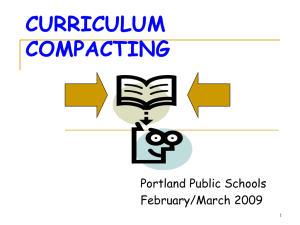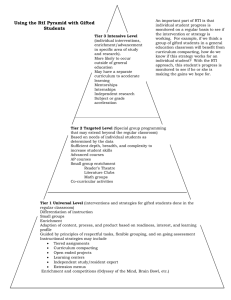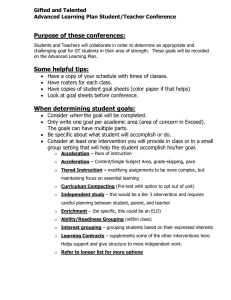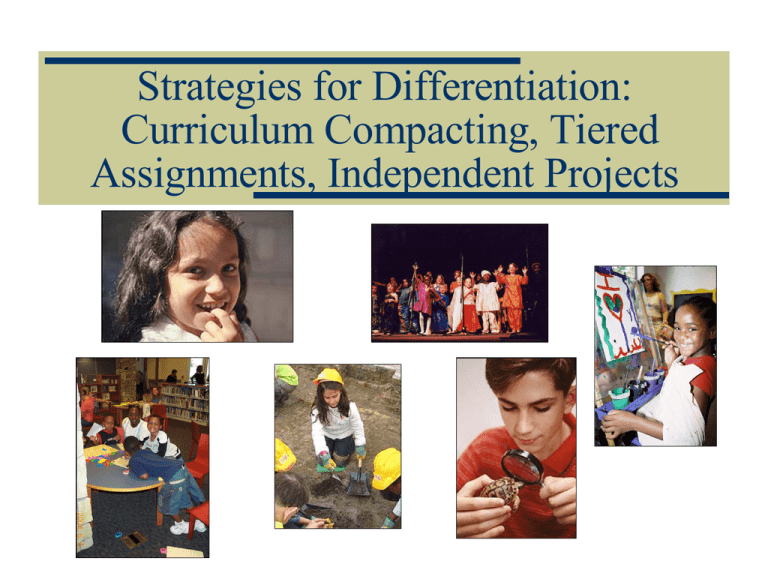
Strategies for Differentiation:
Curriculum Compacting, Tiered
Assignments, Independent Projects
Welcome
George Rislov
Senior Marketing Manager
CompassLearning
Dr. Janis Jordan
Assistant Superintendent for
Curriculum and Instruction
Corpus Christi ISD
Dr. Sally Reis
Board of Trustees
Distinguished Professor at
The University of
Connecticut
Students in our classes are
all so different…
Some have learning differences,
and as Susan Baum explained, the
bright/LD student is a child who exhibits
remarkable talents or strengths in some
areas and disabling weaknesses in
others.
Baum (1991)
Learning Differences in Children
Aptitude and Ability
Achievement
Academic background—poor preparation and limited
exposure
Cultural—second language acquisition, interaction style
differences
Affect (enthusiasm level and personality)
Effort (effort vs. ability issues)
Styles of learning style
(visual, auditory, concrete, hands-on)
Interests
Product and processes
Self-regulation and study skills
What is Differentiation?
Matching appropriately challenging
curriculum and instruction with a
student’s abilities, interests, and
learning styles through a variety of
instructional strategies and challenging
curriculum.
But……………
Is it happening?
Even with good teachers?
Or is differentiation too hard for
most teachers to do well and
consistently?
Too many teachers feel like this on a regular basis;
Differentiation is a Challenging Task.
Way in the Maze of Federal Mandates, Advanced Content, and Standardization
Losing our
Why aren’t you differentiating?
Purpose of Differentiation
1. Enhance learning
match between student
and curriculum;
2. Change depth or
breadth of student
learning;
3. Use varied learning
strategies, groupings and
management;
4. Enable all students to
make continuous progress
in all areas.
Teachers differentiate in five
dimensions:
Curriculum and content
Process skills and instruction
Classroom organization and
management
Student products
Teacher (personal choices and
preferences in how one teaches)
Renzulli’s Five Dimensions of Differentiation
Content
(Knowledge)
Process
(Pedagogy)
You, the teacher
Classroom
Organization and
Management
Products
(Expression Styles)
Why Differentiate?
Standard-based classrooms
No Child Left Behind
Student diversity in all areas
New research on human learning
Rapid societal and technological change
The amount of repetitive content for some
students
Various Strategies Used to
Differentiate
•
•
•
•
•
•
•
•
Curriculum Compacting
Tiered Assignments
Alternate Choice Assignments
Enrichment
Acceleration
Using Higher Order Questions
Grouping Options
Independent Study and Research Studies
Why Not Let High Ability Students
Start School in January?
The Curriculum Compacting Study
Sally M. Reis
Karen L. Westberg
Jonna Kulikowich
Florence Caillard
Thomas Hébert
Jonathan Plucker
Jeanne H. Purcell
John B. Rogers
Julianne M. Smist
The National Research Center on
the Gifted and Talented
INDIVIDUAL EDUCATIONAL PROGRAMMING GUIDE
The Compactor
Prepared by: Joseph S. Renzulli
Linda M. Smith
NAME__________________________________
AGE________ TEACHER(S) _______________________
Individual Conference Dates And Persons
Participating in Planning Of IEP
SCHOOL _______________________________
GRADE_____ PARENT(S) ________________________
_______ _______ _______ _______
CURRICULUM AREAS TO BE CONSIDERED
FOR COMPACTING Provide a brief description of
PROCEDURES FOR COMPACTING BASIC
MATERIAL Describe activities that will be used to
ACCELERATION AND/OR ENRICHMENT
ACTIVITIES Describe activities that will be used to
basic material to be covered during this marking period
and the assessment information or evidence that
suggests the need for compacting.
guarantee proficiency in basic curricular areas.
provide advanced level learning experiences in each
area of the regular curriculum.
Name it.
Prove it.
Change it.
What material needs to be
covered?
Exactly what material is to be
excluded?
What enrichment and/or
acceleration activities will be
included?
What evidence shows a need for
compacting?
How will you prove mastery?
Independent Study
Mini-courses
College Courses
Acceleration
Honors Courses
Mentorships
Small Group Investigations
Work Study
Check here if additional information is recorded
on the reverse side.
Copyright © 1978 by Creative Learning Press, Inc. P.O. Box 320 Mansfield Center, CT 06250. All rights reserved.
In this national study,
we learned that:
Approximately 40-50% of traditional
classroom material could be
eliminated for academically talented
students.
"First grade would be all right if it weren't for the 11 sequels."
Additional findings:
When teachers eliminated as much as 50% of
the curriculum, no differences were found
between treatment and control groups in most
content areas.
In fact, students whose curriculum was
compacted scored higher than control group
students in some areas.
Classroom teachers can use
differentiated instruction to enable all
students to make continuous progress in
learning.
Student Behaviors Suggesting that
Compacting May Be Necessary
•
•
•
•
•
•
•
Consistently finishes tasks quickly
Finishes reading assignments first
Appears bored during instruction time
Brings in outside reading material
Creates own puzzles, games, or diversions in class
Consistently daydreams
Uses vocabulary and verbal expression advance of grade
level
Student Behaviors Suggesting that
Compacting May Be Necessary
•
•
•
•
•
Has consistently high performance in one or more
academic areas
Tests scores consistently excellent
Asks questions that indicate advanced familiarity
with material
Is sought after by other students for assistance
Expresses interest in pursuing alternate or advanced
topics.
INDIVIDUAL EDUCATIONAL PROGRAMMING GUIDE
The Compactor
Prepared by: Joseph S. Renzulli
Linda M. Smith
NAME__________________________________
AGE________ TEACHER(S) _______________________
Individual Conference Dates And Persons
Participating in Planning Of IEP
SCHOOL _______________________________
GRADE_____ PARENT(S) ________________________
_______ _______ _______ _______
CURRICULUM AREAS TO BE CONSIDERED
FOR COMPACTING Provide a brief description of
PROCEDURES FOR COMPACTING BASIC
MATERIAL Describe activities that will be used to
ACCELERATION AND/OR ENRICHMENT
ACTIVITIES Describe activities that will be used to
basic material to be covered during this marking period
and the assessment information or evidence that
suggests the need for compacting.
guarantee proficiency in basic curricular areas.
provide advanced level learning experiences in each
area of the regular curriculum.
Name it.
Prove it.
Change it.
What material needs to be
covered?
Exactly what material is to be
excluded?
What enrichment and/or
acceleration activities will be
included?
What evidence shows a need for
compacting?
How will you prove mastery?
Independent Study
Mini-courses
College Courses
Acceleration
Honors Courses
Mentorships
Small Group Investigations
Work Study
Check here if additional information is recorded
on the reverse side.
Copyright © 1978 by Creative Learning Press, Inc. P.O. Box 320 Mansfield Center, CT 06250. All rights reserved.
Goals of Compacting
Create a challenging learning environment for all
children!
Define objectives and guarantee proficiency in basic
curriculum.
Find time for alternative learning activities based on
advanced content and individual student interest.
Individual Educational Programming Guide—
The Compactor
N ame
Age
Teacher
School
Grade
Parent(s)
Curriculum
Areas to Be
Considered
for
Compacting
Procedures
for
Compacting
Basic
Materials
Individual Conference
Dates and Persons
Participating in Plan ning
of IEP
Acceleration
and/or
Enrichment
Activities
Types of Compacting
Basic Skills Compacting:
•Eliminates specific skills that students have
already acquired.
•Spelling, mathematics, or grammar.
•Pre-testing is easier to accomplish.
•Mastery can be documented more easily /objectively.
Content Compacting
•Social studies, science, and literature
•Students may already know the objectives or may be able to read the
material and master the objectives in a fraction of the time.
•More flexible–students can absorb the material at their own speed.
•Evaluation may be less formal– essays, interviews, or open ended
tasks
INDIVIDUAL EDUCATIONAL PROGRAMMING GUIDE
The Compactor
Prepared by: Joseph S. Renzulli
Linda M. Smith
NAME__________________________________
AGE________ TEACHER(S) _______________________
Individual Conference Dates And Persons
Participating in Planning Of IEP
SCHOOL _______________________________
GRADE_____ PARENT(S) ________________________
_______ _______ _______ _______
CURRICULUM AREAS TO BE CONSIDERED
FOR COMPACTING Provide a brief description of
PROCEDURES FOR COMPACTING BASIC
MATERIAL Describe activities that will be used to
ACCELERATION AND/OR ENRICHMENT
ACTIVITIES Describe activities that will be used to
basic material to be covered during this marking period
and the assessment information or evidence that
suggests the need for compacting.
guarantee proficiency in basic curricular areas.
provide advanced level learning experiences in each
area of the regular curriculum.
Name it.
Prove it.
Change it.
What material needs to be
covered?
Exactly what material is to be
excluded?
What enrichment and/or
acceleration activities will be
included?
What evidence shows a need for
compacting?
How will you prove mastery?
Independent Study
Mini-courses
College Courses
Acceleration
Honors Courses
Mentorships
Small Group Investigations
Work Study
Check here if additional information is recorded
on the reverse side.
Copyright © 1978 by Creative Learning Press, Inc. P.O. Box 320 Mansfield Center, CT 06250. All rights reserved.
Column One:
• Identify the objectives in a given subject area.
• Eliminate instructional time for students who show
mastery of the objectives.
• Streamline instruction of those objectives students have
not yet mastered but are capable of mastering more
quickly than classmates.
• Offer challenging alternatives for time provided by
compacting.
Individual or small group projects using
contracts or management plans
Interest or learning centers
Opportunities for self-directed learning or
decision making
Mini-courses on research topics or other high
interest areas
Replacement activities must be based
on:
The needs of the students
Time
Space
Resources
School policy
Support personnel
Keep records of this process and the
instructional options available to
compacted students
How to get started:
Start Small: Start the compacting process by targeting
a small group of students for whom compacting seems
especially appropriate.
Select One Content Area: The targeted student
has demonstrated previous mastery or curriculum
strengths. Teachers have the most resources available to
pretest for prior mastery and to enrich and accelerate the
content.
How to get started:
Experiment with Pretesting or Pre-assessment:
•Try different methods of pretesting or assessment.
•Be flexible in accomplishing this by experimenting with
different systems.
•Ask for assistance from other faculty members, aides, or
volunteers.
•Decide in advance what score constitutes a pass.
Compact by Topic: Compact by unit, chapter, or topic
rather than by time (marking period or quarter).
Experiment: Keep trying, reflecting on
what has worked, and field testing new ideas.
Reis, S. M., Burns, D. E., & Renzulli, J. S. (1992). Curriculum Compacting: The complete guide to
modifying the regular curriculum for high ability students. Mansfield Center, CT: Creative
Learning Press.
One thing is clear. We don’t
have the option of turning away
from the future. No one gets to
vote on whether technology is
going to change our lives.
Bill Gates, The Road Ahead
Ways to Differentiate Content:
Learning Centers
Acceleration
Independent or Group Type III Projects
Grouping
Renzulli Learning
Other Strategies for Differentiation
Compacting
Independent Study
Tiered Assignments
• Ensures that students with different learning needs
work with the same essential ideas and use the same
key skills but at different levels of:
complexity
abstractness
open-endedness
What can be tiered?
Assignments
Activities
Homework
Learning
Centers
Experiments
Materials
Assessments
Writing Prompts
Projects
Independent Projects
Builds student interest
Satisfies curiosity
Planning and research skills
at advanced levels
Encourages independence
Enables work with complex
& abstract ideas
Allows long-term and indepth work on topics of
interest
Taps into high motivation
The Wizard Project Maker Step-by-Step Tool
TM
The Wizard Project Maker Step-by-Step Tool
TM
Check the boxes below of all the ways you intend to get new information to complete
your project and list the specific sour ces:
Viewing TV, videos, films, etc. (which?) ____________________________________
Interviewing people (who?) ______________________________________________
Observing/collecting data (what?)
________________________________________
Surveying (who?) ______________________________________________________
Taking a class or working with a mentor (specify) ___________________________
Attending a performance (specify) ________________________________________
Other (specify) _________________________________________________________
List all materials and equipment needed:
TASKS: List in order
1.
________________________________________
2.
________________________________________
To be completed by:
______________________
______________________
3.
4.
5.
6.
7.
8.
9.
________________________________________
________________________________________
________________________________________
________________________________________
________________________________________
________________________________________
________________________________________
______________________
______________________
______________________
______________________
______________________
______________________
______________________
10.
11.
________________________________________
________________________________________
______________________
______________________
I realize that it is my responsibility to have the appr opriate resource materials to work
with in class everyday.
____________________________
Student Signature
____________________________
Resource Teacher
Grouping for differentiation!
Flexible grouping within classrooms
Cluster grouping within and across classrooms
Separate classes for gifted and high achieving
students
BUT: IT IS NOT THE GROUPING THAT
MATTERS, IT IS WHAT HAPPENS WITHIN THE
GROUPS!
What is Differentiation?
Matching appropriately challenging
curriculum and instruction with a
student’s abilities, interests, and
learning styles through a variety of
instructional strategies and challenging
curriculum.
It Begins with Good Instruction
How will you start to
differentiate?
Questions?
Extended Learning Opportunities
2012 Southwest Building Learning Communities
Curriculum and Technology Conference
June 19-22
Frisco, Texas
Registration information at http://txascd.org
CompassLearning White Paper on Differentiation
Written by Dr. Sally Reis and Dr. Joseph Renzulli
Available on the tab below the slides and also at
http://www.compasslearning.biz/forms/differentiation

